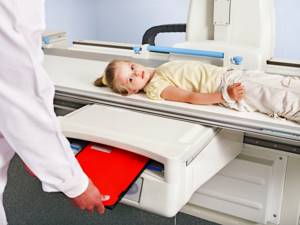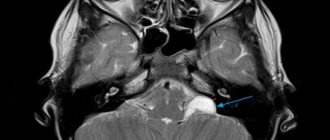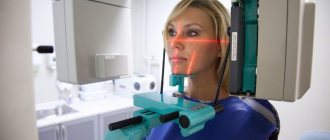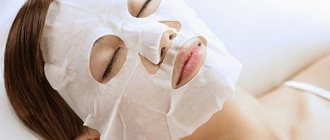X-rays instead of Mantoux are performed for certain indications or when parents refuse tuberculin diagnostics. Doctors believe that Mantoux is more informative because it allows you to detect the presence of Koch's bacillus in the body and diagnose tuberculosis in any location. X-ray is advisable only for diagnosing already developing pulmonary tuberculosis.
According to Federal Law No. 77, parents have the right to refuse any research and analysis as part of anti-tuberculosis measures. In case of pressure from medical workers and refusal to admit a child to preschool/school institutions, it is worth referring to the Federal Law, because departmental acts that contradict it are not mandatory.
When can you take x-rays instead of Mantoux?
X-rays instead of Mantoux can be done only in certain cases:
- the child has been diagnosed with an allergy to injected tuberculin;
- there are medical contraindications to performing the Mantoux test;
- parents voluntarily refuse tuberculin diagnostics.
Bronchial asthma is an absolute contraindication to the Mantoux test
When can and when should children be examined?
Doctors recommend that a child undergo fluorographic screening if he has already reached the age of 14 and it is not advisable to perform a Mantoux test. Fluorography is done when the risk of infection with Mycobacterium tuberculosis increases sharply during an epidemic or after visiting a source of infection or contact with a patient suffering from active tuberculosis. The study is prescribed to confirm the diagnosis if parents brought a child to the appointment with complaints typical of tuberculosis, or other examinations revealed signs of tuberculosis. Fluorography is necessary to determine the cause of respiratory disease in children if symptoms of tuberculosis are present, but the Mantoux test turned out to be negative and the likelihood of contact with a carrier of an open tuberculosis infection is excluded.
From what age
At what age is a child allowed to undergo fluorography and why - the answers to these questions are very important for parents whose children have been sent for examination. Fluorography is allowed for children only from 15 years of age.
At the age of 14, the doctor will write out, if necessary, a referral for an x-ray or ultrasound of the chest organs - these research methods are considered safer. Before this age, even a small dose of radiation can cause serious complications and disturbances in the development of the child. The region of conduct of the survey and the epidemiological situation play a major role. Thus, until recently, both in Ukraine and Russia, teenage children began to undergo fluorography at the age of 14. However, according to the new legislation, in Russia children now undergo fluorography from the age of 15, while in Ukraine it is still from 14, since an epidemic of tuberculosis is being recorded in Ukraine, while in Russia statistics show a decrease in incidence.
Indications for pediatric fluorography
Children's fluorography is necessary regardless of age, since the risks of the procedure are less than the risk of not diagnosing tuberculosis:
- in cases where a diagnosis is necessary after a positive Mantoux test;
- if the child’s surroundings include people suffering from active tuberculosis infection;
- with pronounced signs of tuberculosis infection.
Contraindications for children's fluorography
The main contraindications to chest screening in children are age under 15 years and a general weakened state of the body. Radiation, even in small doses, is tolerated worse by children than by adults; cellular immunity and hematopoietic organs are primarily affected. One exposure to radiation, even in minimal doses, for a small child can be enough to lead to disruptions in their functioning.
Important! The younger the child, the less informative fluorography is. The image is received in a reduced size; it will be difficult to accurately examine the changes and their nature. Therefore, in most cases, an x-ray will be performed, giving a life-size image, or an ultrasound.
Mantoux and fluorography are the same thing
Mantoux and fluorography are not the same thing, because the manipulations are radically different:
- Mantoux test - subcutaneous injection of tuberculin, which allows you to find out the body's reaction to it and understand whether Koch bacilli (the causative agent of tuberculosis) are present in the body;
- fluorography is an examination of the chest that allows one to identify an already developing disease in the respiratory organs.
We recommend reading about blood tests for tuberculosis instead of Mantoux. From the article you will learn about in what cases Mantoux can be replaced with a blood test, types of laboratory blood tests for tuberculosis, and their comparative characteristics. And here is more information about what doctors think about the Mantoux vaccination and whether it is necessary to do it.
What can be detected on fluorography in children?
Fluorography is done for children to identify predominantly tuberculosis infection in the lungs. But in addition, this examination will show:
- Changes in the bone structures of the chest.
- Vascular and cardiac disorders.
- Damages of the respiratory system not associated with tuberculosis infection - injuries, neoplasms.
Although fluorography is one of the mandatory methods of examining a patient for suspected tuberculosis, its results are not the main diagnostic criterion. To make an accurate diagnosis, a number of additional studies and tests will be required, for example, Diaskintest, PCR diagnostics, bronchoscopy. All adults undergo fluorography in Russia for early detection of pulmonary tuberculosis. Children under 15 years of age undergo fluorography in emergency cases, if other diagnostic methods are not applicable.
By law, parents have the right to refuse such chest examinations. But at the same time, you should be aware of all the possible risks and consequences of the decision and be sure to choose an alternative method of examining the child.
What does the law say about x-rays instead of samples?
According to the law of the Russian Federation, instead of the Mantoux test, x-rays cannot be given to children under 14 years of age unless the parents give their consent. The law clearly states that the Mantoux test is carried out for prophylactic purposes for early detection of Koch bacillus infection. It turns out that replacing tuberculin diagnostics with x-rays is also a preventive measure, and to carry it out, doctors need to obtain the consent of official representatives of the person being examined.
Federal Law No. 77, Article 7, paragraph 3 clearly states:
...anti-tuberculosis care for minors under 14 years of age is provided with the consent of their legal representatives.
Current legislation does not provide for any consequences for refusing Mantoux - specialists cannot insist that the child undergo additional examinations and undergo specific tests.
Mantoux test - advantages and disadvantages
Familiar from childhood, the Mantoux test was first carried out on a large scale in 1975. Now this method of diagnosing tuberculosis is an annual event in children over one year of age.
Some people mistake Mantoux for a vaccine against tuberculosis. This is far from true. It only shows how effectively the body is able to fight the disease and whether the patient needs revaccination.
The described test involves the introduction of tuberculin into the child’s body - a drug obtained by extracting processed tuberculosis bacteria and their metabolic products. The concentration of the active substance is so low that it causes virtually no side effects. However, an immune response is possible. It is by the skin reaction that the presence of tuberculosis and immunity to it is judged.
When tuberculin drugs are administered intradermally, a specific reaction of the body occurs. It can be post-vaccination or infectious. There is nothing to fear from the first type of reaction - after vaccination, the child has developed antibodies, the immune system reacts to a familiar infectious agent. But with the second, the doctor will rush to prescribe an additional examination and, based on its results, treatment. The presence of the disease is indicated by the size of the papule that forms at the injection site. A spot no larger than 4 mm in diameter is considered normal. If this size is exceeded, specialists suspect infection and prescribe tests.
The advantages of the Mantoux test include:
- frequency – once a year;
- no need to visit a clinic - the test will be done at school or kindergarten;
- availability;
- versatility.
However, this diagnostic method has a number of disadvantages, namely:
- dependence of the result on the reactivity of the child’s body: in children prone to allergies, there is a high risk of a false positive response. Weakened immunity also leads to distorted tuberculin test results;
- special rules for administering the drug and behavior after injection: tuberculin is administered strictly intradermally, otherwise distortion of the test results cannot be avoided. After the manipulation, the injection site should not be scratched or rubbed, which is not always possible in children;
- the risk of developing allergies - this usually concerns patients prone to it. In them, the introduction of tuberculin can provoke the appearance of urticaria, and sometimes more serious symptoms, including anaphylactic shock;
- the information content of the sample is less than 50 percent.
What is more harmful for a child, what is safer?
What is more harmful or safer - Mantoux or X-rays for a child - no doctor can answer. The fact is that these manipulations do not cause the development of tuberculosis, and in the case of x-rays, not a single case of the development of radiation sickness in a child has been recorded.
The Mantoux test can provoke the development of a severe allergy, which can be treated with antihistamines. X-rays are also now a safe procedure for minor children - irradiation is carried out in small doses and according to a clearly planned frequency schedule for the procedure.

With modern X-ray machines, the child receives a minimal dose of radiation
Radiography - advantages and disadvantages
X-ray is a procedure that is used as a last resort, especially for minor patients. The fact is that ion irradiation has a negative effect on the developing child’s body, so serious reasons are required to prescribe such a study as radiography. These include:
- the baby has clinical signs of tuberculosis;
- the Mantoux test gave a sharply positive (hyperergic) reaction;
- there is a possibility of infection, confirmed by other examinations.
This method has both advantages and disadvantages.
An undoubted advantage is the accuracy of the result. The image will show the presence of the disease. Besides, x-rays are not as dangerous as they might seem. Today, research is carried out using digital devices, the radiation of which is minimized. During the procedure, all unused parts of the body are covered with a special lead apron.
Of the minuses it is worth noting:
- impossibility of conducting an annual examination (x-ray is a method used to confirm the result of another examination);
- radiation hazard;
- age limit.
X-rays are not recommended for patients under 14 years of age, especially infants, and pregnant women.
However, the doctor may authorize the examination if the child:
- repeated attacks of bronchial asthma;
- there is an immune deficiency;
- It is necessary to test the effectiveness of cystic fibrosis therapy.
A doctor has no right to force a patient to take an x-ray. Parents or other legal representatives make decisions for a minor child.
What is better and more effective – Mantoux or X-ray
Doctors believe that the Mantoux test will be better and more effective than x-rays:
- tuberculin makes it possible to detect the presence of Koch's bacillus in a child's body, even if symptoms of the disease are completely absent;
- Mantoux makes it possible to diagnose tuberculosis localized in any organ or system;
- An x-ray will show only existing pathological foci in the lungs.
Watch this video about the types and signs of tuberculosis on x-ray:
How to avoid trouble due to refusal of a lung x-ray instead of Mantoux
Often, when parents refuse an X-ray of the lungs instead of Mantoux, doctors take a hostile position and do not allow the child to enter kindergarten or school. In fact, this behavior of medical workers does not comply with Federal law, and parents can defend their rights. It is necessary to start a written dialogue with doctors and the head of the clinic and in the first appeal be sure to indicate the following:
- your full name and what became known about the preliminary decision to prohibit the issuance of a medical certificate for admission to a kindergarten or school;
- emphasize that this is categorically contrary to Federal Law and refer to Art. 32 (consent to medical interventions for a child under 15 years of age is given only by their official representatives), Art. 5, paragraph 1 (the right of citizens to refuse vaccinations and other manipulations as part of the prevention of tuberculosis);
- indicate knowledge of Art. 7, paragraph 3 (any anti-tuberculosis assistance to minors under the age of 14 is provided only with the consent of their official representatives);
- mention the Constitution of the Russian Federation, Article 43 of which states the right to education, including preschool education, regardless of religion or health status.
A written dialogue with representatives of a medical organization should begin only after the child has undergone a general medical examination and received reports on the state of health from an ENT specialist, ophthalmologist, surgeon, orthopedist, and has taken blood, urine, and stool tests for enterobiasis and worm eggs. Supplement these data with a description of the patient’s health status (no hyperthermia, no excessive sweating, weight is within normal limits, appetite is not reduced, and so on).
At the end of the statement, it is worth emphasizing that any departmental documents that contradict Federal Law are illegal and cannot be enforced.
The application is drawn up in 2 copies; if one of them is not accepted at the medical institution, then it is worth sending it by mail with acknowledgment of receipt. The next step, if pressure continues on the parents, is a visit to the prosecutor's office with the previous application (copy) attached.
We recommend reading about how to write a refusal from Mantoux. From the article you will learn about the reasons for refusing Mantoux, how to write a refusal, the consequences, and visiting a TB doctor afterwards. And here is more information about why to visit a TB doctor after Mantoux.
An X-ray instead of Mantoux can be done as part of the detection of tuberculosis, but only if the parents agree to such a study. According to the Federal Law, representatives of minors under 14 years of age may refuse tuberculosis prophylaxis and any tests as part of its diagnosis in the absence of a clear clinical picture of the pathology.
What diagnostic methods exist

How can you safely examine a child for pulmonary tuberculosis without performing a tuberculin test? Many parents are puzzled by this question today, since no one likes to take their child to a tuberculosis clinic when dubious results are revealed. Currently, the most common methods are the introduction of Tuberculin and fluorography, but a lot of controversial information and negative reviews have appeared around these diagnostic methods. Phthisiatricians assure that there are other effective methods that will help identify reliable results, and at the same time are guaranteed not to cause harm to the child’s health.
Since a law has been adopted according to which preventive examinations of children attending children's educational institutions are mandatory, it is impossible to refuse the diagnosis of tuberculosis. Mass vaccination is mandatory and is carried out once a year. If a child has not been diagnosed and does not have the appropriate certificate, he will not be allowed into any educational institution.
According to statistics, many parents are afraid to make Mantoux for certain reasons. This is due to the fact that the test often gives a false positive result. In addition, it is believed that administering Tuberculin, even in a minimal dosage, is unsafe for health. The legislation has established that parents have the right to refuse a tuberculin test, but it will have to be replaced by another method.
As an alternative use:
- Blood analysis. In practice, this diagnostic method is rare, more often if the patient has a positive reaction. Taking blood to detect mycobacteria in the body is called ELISA (enzyme-linked immunosorbent assay) or PCR (polymerase chain reaction). This diagnostic method does not give a false positive reaction and is considered the best alternative to Tuberculin.
- X-ray. Most doctors do not recommend taking x-rays instead of Mantoux, since ionizing radiation negatively affects the baby's health. Radiography is necessary if a positive result for the presence of Koch bacilli is revealed during third-party diagnostic methods. In such a situation, an x-ray is necessary, as it will help identify the exact clinical picture and find foci of pathology.
- Diaskintest. Subcutaneous injection of recombined tuberculosis allergens.
- Quantiferon test. Its action is very similar to Diaskintest, only the composition is not administered subcutaneously, the blood is mixed with other reagents in a test tube.
- Fluorography. This method of identifying pathogenic mycobacteria is “classical”; it is carried out only after 14 years.
Each diagnostic method has advantages and disadvantages, so it is recommended to choose a method together with a doctor who will tell you what is more relevant in a particular case.








